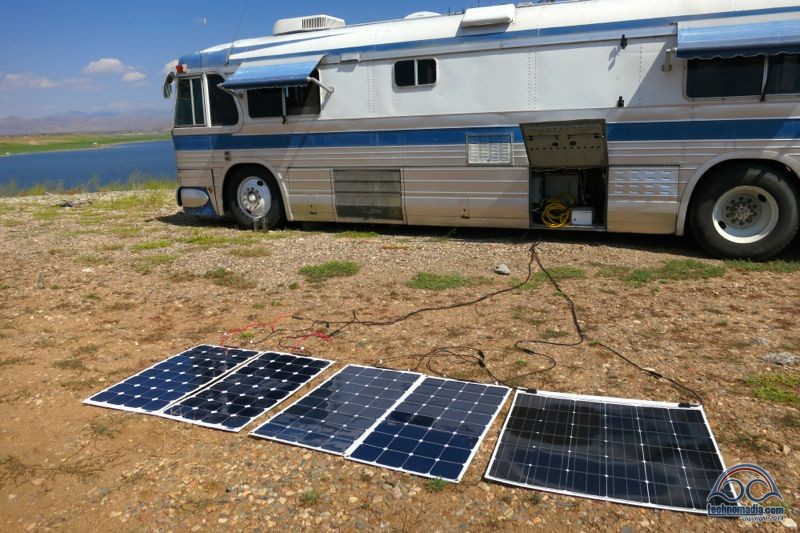
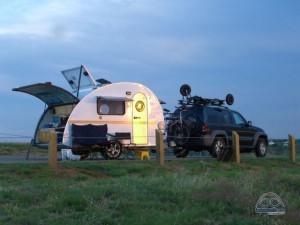
I have been a fan of solar power as long as I have been living on the road.
One of the first projects I tackled when I first became nomadic way back in 2006 was adding 130W of solar to the back of my tiny Tab Clamshell. I think it was my abundance of sexy solar power that helped me win Cherie’s heart – our first date I let her plug into the sun and the rest was history.
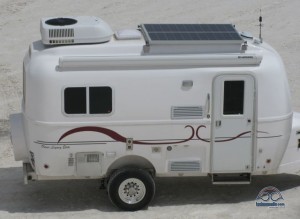
When we had our Oliver custom made for us, we designed 200W of solar in from the get-go – and it was an essential enabler for our style of life on the road.
Many of our first four years on the road were spent unplugged, and relying on solar energy with very little generator use.
So how is it that we have gone over three years without adding solar to Zephyr, our absolutely awesome vintage 1961 bus?
A few reasons:
- Eastcoast bound – Moving into Zephyr coincided with a desire to be based primarily out of Florida for family reasons. Which meant we’d be staying in RV Parks with electrical hook-ups anyway. This pushed the priority of investing in solar way to the back burner, as we knew the longer we waited the more technology would evolve.
- Increased Energy Appetite – Back in our trailer days we relied on propane appliances, the bulk of our electrical needs were carefully optimized to run off of DC 12V power, and we spent our workdays staring at power-efficient laptop screens. All that has changed.In Zephyr we have gone propane-free, and thus rely on electric for our refrigeration needs – we have a Danfross compressor based DC fridge from Vitrifrigo, a convection/microwave oven, and an induction cooktop. We spend our workdays staring at big beautiful 27″ & 30″ monitors. And while we have kept power efficiency in mind, our systems are a mix of AC and DC powered and we often keep our inverter on 24/7 to power it all.
In other words – our power demands have gone way up. 130W or 200W isn’t going to cut it anymore – we need substantially more power up on top. It is going to take an elaborate and carefully planned out full-roof system to keep on top of most of our power needs.
- Sweet Sexy Curves – Then comes the bigger challenge… We absolutely love Zephyr’s vintage 1961 classic curves, but her gently rounded roof leaves very little flat space suitable for traditional thick, flat, framed solar panels. Only thin panels that can meld with the roof lines will look good on our girl. But there just aren’t many thin and flexible options out there!
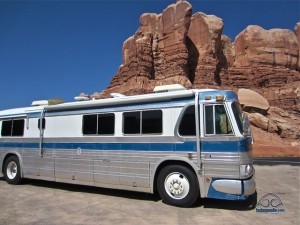
Every year I’d spend a week or two researching the latest state of the art in solar, hoping to find the perfect companion to tie into our sweet Lithium Ion battery setup, only to end up not ready to jump yet.
There just wasn’t any affordable and attractive way to fit the amount of solar power that we wanted onto Zephyr’s roof, and we didn’t like the idea of investing in half-measures that would still keep us dependent on regularly finding hookups or spending excessive amount of time listening to a generator drone.
We knew that ultimately only thin and flexible panels would be able to mesh nicely to our curved roof – and every year we’d decide that none of the options felt worth investing in.
Until now… perhaps.
Is 2014 the year that Zephyr at last goes solar? Has solar technology at last caught up with the needs of our 53 year old bus?
We’re in the midst of a major investigation…
The Solar Challenge: The Goal
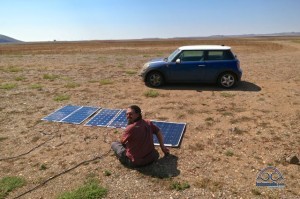
Our goal is to design a system for Zephyr capable of powering the bulk of our typical energy needs for several days without needing to regularly resort to a generator.
We expect that this will require somewhere between 500W to 1000W of solar, with the ultimate goal being to install as much power as we can while still looking good. Because when it comes down to it, you really can never have too much power.
With such a major investment planned – we wanted to do it right the first time. That means a lot of design and research work up front picking the ideal components – and especially picking the best panels.
And of course – cost is a consideration. It is not necessarily the top concern, but overall value of the system needs to be balanced with the desire for peak performance.
RV Solar Resources
A ton has been written online about solar, but not a lot has been written from the RVers perspective. And a lot of what has been written is not in-depth and often actually incorrect about a lot of important details.
The best online resources we have found, and we have consulted personally with them all:
- Jack Mayer’s RV Electrical & Solar Page – Jack has compiled an incredible online resource about RV solar and electrical systems.
- HandyBob Solar – Bob is strongly opinionated, but he has seen it all and shares a lot of great information and real-world examples.
- AM Solar – AM Solar has probably installed more solar systems on RV’s than anyone else, and they have an excellent reputation for quality work, products, and advice. Their “RV Solar Education” series is a must-read.
But despite all this information available, we haven’t found anyone who has done much head-to-head testing of different setups and scenarios. Actual real-world data, especially comparative data, is almost impossible to come by.
And when it comes to thin and flexible panels, there just isn’t much solid unbiased information available out there at all. Some folks have written about the system they installed, but we haven’t found anyone who has published much comparative analysis of the options available.
Solar Challenge Preview
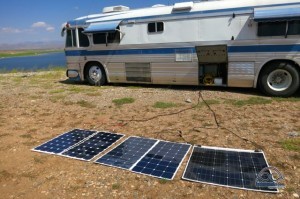
As we began the research on this project, I reached out to several solar companies to ask if they would be interested in participating in some no-strings-attached unbiased head-to-head testing.
To our delight, so far we have gotten gear to evaluate from:
- Victron – Victron (the maker of our awesome MultiPlus Inverter) has sent us a pair of BlueSolar 50A MPPT Solar Charge Controllers, and I have set them up to allow for direct head-to-head panel testing.
- Go Power – Our dear friends the Wynn’s have written about their experiences with Go Power panels, and they put us in touch with the company who agreed to send us 2x 100W Solar Flex panels for testing, as well as their basic PWM charge controller.
- Grape Solar – Grape Solar was also excited by the project, and sent us 2x 100W Photo-Flex panels for testing.
- HighFlex Solar – HighFlex Solar was the first to pioneer high-efficiency thin and flexible panels, and now they are the first to design panels with integrated MPPT chips directly on the panel to optimize power output. We were very excited when they agreed to send us one of their 156W panels, and we are eager to see if it lives up to its potential.
We hope to add a few more contenders to the mix as well, but this collection of gear has given us some great data already.
With the capability of testing panels head-to-head under identical real-world conditions, we aim to be able to actually measure the differences in performance between these panels under a range of testing scenarios.
The testing will continue over several months to give us time to conduct a range of experiments, and to try and observe how durable and scratch-resistant the panels are as well. We will be sharing all our results in a series of blog posts here.
What have we learned so far?
You’ll just have to stay tuned here to find out…
Solar Quest Questions
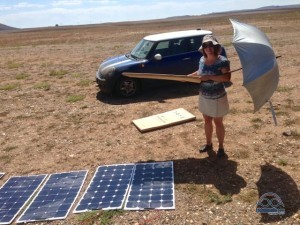
We’ve fielded a lot of questions about solar over the years.
Along with sharing our testing results, we are also setting out to answer a bunch of key questions through a mix of research and actual real-world measurement and experimentation.
Some of the questions we hope to address over the coming months of blogging about this project include:
- How much solar is really needed? How should an RV system be properly sized?
- What are the classic mistakes commonly seen in RV solar installations? What are key tips to avoid them?
- What is the difference between a PWM and MPPT controller? Is MPPT worth it? Is there any advantage to integrating an MPPT controller directly into the panel, like High Flex Solar has?
- What are the downsides of thin and flexible panels versus traditional glass panels?
- What is the impact of wire size and length on a solar system install?
- What are the trade-offs of wiring panels in series versus in parallel?
- What are the impacts of mixing-and-matching non-identical panels?
- How much does shade, shadows, and clouds effect solar panel power output?
- How much does flat roof mounting impact power output versus being tilted towards the sun? What impact does bending along a roof curve have?
- Is it possible to run an air conditioner off of solar power?
- And critical for us – what are the best thin and flexible solar panel options out there?
- And finally – is investing in solar really worth it?
Along the way while answering all these questions over a series of blog posts, we aim to explain the basics of solar power – and the keys to designing a great system – whether using thin panels or traditional.
We hope you will follow along – you will be able to access all of our solar related posts from our new RV solar page.

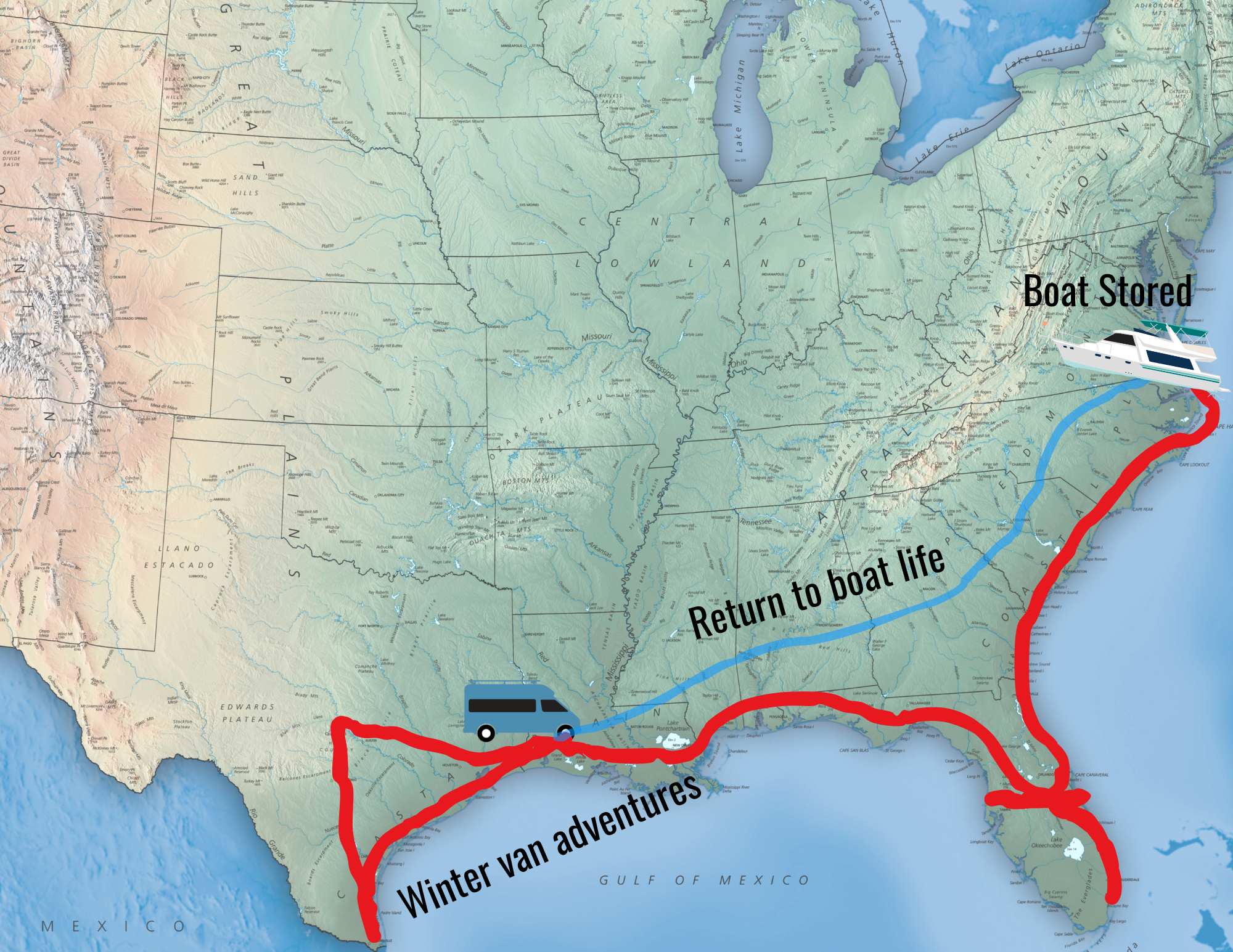
I am having Five 100W Go Power Flexible panels installed, and will see how they hold up over time. I still think they are the best idea for my curved rubber roof Class A, and don’t want the extra weight of Glass panels up there. I figure even though they only have a 10 year guaranty, compared to glass, it’s a reasonable trade off.
Jim
Almost all the reviews on flexible solar panels (Gone with the Wynns etc.) have talked about the cons like bird poop, cupping, scratches, and chips, but they don’t report a loss of performance. Why convert to glass panels if the flexibles work fine even with damage? Sounds like a pro not a con to me.
We did see performance dropping off – and AM Solar saw substantial dropping in their test installation over time. After 5-10 years I’d expect flexible panels to really be showing their age, and suffering in performance.
It seems that glass panels age a lot slower than flexible panels.
– Chris
I bought flexible panels from Renogy. Unfortunately, a bird has pooped on them and one thing that has maybe not been mentioned enough about these flexible panels: The bird poop melts a permanent stain on the plastic. It looks like a very thin mineral deposit left behind after cleaning off the poop. However, vinegar does not get rid of it.
Another theory I read is that the poop is acidic and melts the plastic and gives it a roughness.
Looks like I’ll have to wet sand the poop off.
Be very happy that you all decided against flexible panels.
Wow – permanent damage from a little bird poop is a major issue! Thanks for sharing about it.
Have you noticed any changes in the performance and power output since the poop scarring?
– Chris
Hi Chris – I just rediscovered this thread & your hanging response.
I didn’t see any difference in the performance of the panel with the poop, but then I haven’t really done an exhaustive suite of tests either. the OC voltage and SC current seemed the same as the others.
I just found this thread again looking for “wet sand panels” & found my own post. I am about to replace the flexible panels with conventional ones. But I’m a little bit bummed about it because the flexible panels were so lightweight. (& our camper has weight issues… here in Europe you can even be fined for being overweight though it is rare.)
Interesting, I’ve been hearing about things like that. Was wondering whether a thin, clear protective film/layer of something could be applied to the tops to protect these flexible panels. I had something from 3M applied to the front of a car I had a few years ago (called ‘Clear Bra’, I believe). It was really protective and stayed clear (i.e., didn’t yellow or become milky) for the 7 years I had the vehicle.
I asked the tech at Grape Solar today about adding something like that to the panels, he said he didn’t know. Also asked the guy that runs AM Solar (Oregon) the same question. He said, “It depends on what you use.” (pretty logical).
Any thoughts about that — something that not only protects flex panels from scratches and chemicals (like bird poop), but also might make them age better (not loose output over time as quickly) and yet not block whatever light waves are needed to convert to solar. It seems like there would be something, even some liquid chemical ‘finish’ or ‘sealant’ -type product?
I probably just revealed that I might have slept through some basic science class (i.e., on sun/light processes).
Anyway, it would be nice to find something — I just ordered 8 Grape Solar 100 watt flexible panels from Amazon. I’m thinking about their 12v refrigerator, too.
I can’t find any review of the GE Innovations 48v air conditioner anywhere on the web (not a good sign, I suppose). May go with LG mini split if I can find an installer for an RV.
Thanks for the information and sharing your experiences. Good traveling!
Any “screen protector” applied to solar panels will have some impact on the power produced – but it might be worth some experimentation to find something with as minimal impact as possible.
The only way to know you were making a difference would be to do head-to-head testing with two solar controllers and identical panels so that you can measure the impact. It is a worthy experiment – if you try it, come back here and share your results.
– Chris
I think I will experiment.
Looks like I’ll have 3 strings of four (100w) panels, so I can choose two different films on one panel in each of two of the strings and have the entire third string w/o any film, and I can monitor the amps coming in off of each string (if there’s a battery monitor/controller that can do that).
I’ve purchased the panels and they’ve started arriving (FedEx), and I purchased a LiFeYPo battery storage system which, according to the company CEO (he just called me when he got my order/payment info) will be ready for ‘will-call’ pickup in 2 1/2 weeks, We’ll see.
Haven’t made final choice for inverter but leaning towards the Magnum 4400 Watt, 48V, Parrallel Inverter, based on your rec (the company, if not that model) and others.
Really don’t even have a short list for charger/controller, monitor, switches (wire, etc).
And, still doing searches for other “geek/pioneer users” who are experimenting with getting the flexible panels up off the roof a few inches (once the vehicle is parked) to keep them cooler, the voltage up and hopefully maintain longevity. Can’t believe no company is making a simple, lightweight, adaptable, super-low profile rack/frame system that springs or lifts (like miniature version of the lifts on pop-top campers) w/ a simple latch release system — a couple on the edge of panels at the front end of the RV and one or two on each other side). Hopefully, someone will design one.
who are experimenting with getting the flexible panels up off the roof a few inches (once the vehicle is parked) to keep them cooler, the voltage up and hopefully maintain longevity. Can’t believe no company is making a simple, lightweight, adaptable, super-low profile rack/frame system that springs or lifts (like miniature version of the lifts on pop-top campers) w/ a simple latch release system — a couple on the edge of panels at the front end of the RV and one or two on each other side). Hopefully, someone will design one.
Hi CP… it isn’t letting me comment on the post where you ask about controllers.
Definitely get yourself one of these bad boys: http://electrodacus.com I’ve got his version from last year which works wonderfully. His new versions look way better.
The future is looking bright.
I’ve had three flexible panels. They all developed intermittent wiring problems. Essentially the panel would drop in output but, if you bent it just right, the output would go back up. Because of the top seal, I didn’t want to try to repair the connections, though I’m sure it was a connection, somewhere. These were basically in motion, affixed to a roof, so they got a fair amount of vibration. It definitely took 1-3 years to show up.
There are still some of the ‘roll out and stick down’ roof solar systems. I think the company went bust, but some people like the one foot by nine foot configuration. You removed the backing and pasted them down. I think they were designed to fit in the channels of metal roofing, say on a warehouse.
Good luck. I like the bus. I did solar in a Lance camper, full timing a year in ’04. Aside from solar, prices are pretty high, these days. There are not so many places that are just wide open for the pickin’.
The company with the long rolls of stick-on panels you are thinking of is probably UniSolar. Their technology was not very efficient per square meter, but in every other regard it was promising. A shame they went under.
What brand panels did you have that failed?
Definitely durability is a concern for anything that is always in motion!
– Chris
The most recent flexible was sold by HQRP. There were a lot of Chinese companies selling the same, or similar, panels, on Ebay. Two earlier panels were probably marketed by Amoco, when American oil companies got into solar way back. The panels worked until they were permanently mounted, then they lasted about a year.
I noticed the panels from Renogy are now selling for a lot lower price, the flex panels, but they may not be in your tests. I can understand that many of these retail dealers are pretty small scale, so giving away panels might not be a good business decision. I had 4 4v panels from an early commercial solar site they tore down. That solar site worked for 15 years and the repurposed panels on my Lance camper are still going strong, 20 years later. Durability is nice. Rigid mounts seem to have a proven record.
I knew a solar retailer in the 80’s, and he had done a fantastic bus conversion. He had a lot of panels on the roof, and a huge bank of batteries in the center compartment. I don’t recall the aesthetics. (That bus of yours reminds me of episodes of The Fugitive, which may be before your time.)
With the availability of high wattage grid tie panels you could certainly get a lot of watts for a reasonable amount of money. I always thought the diesel and space on a bus made getting a lot of panels, and a lot of lead acid batteries, feasible, but I guess not. I use evaporative coolers.
I have a picture of a Class A motorhome with solar panels hanging off it, and wind turbines, and ham radio antennae. (not sure how to post it). I’m pretty sure that is not the look you are going for. It’s a nice bus, and I could see where you would want to respect the look.
Hi George –
I’ve seen that classic picture you are referring to with the RV absolutely covered with a seemingly impossible amount of solar panels – that is indeed an extreme setup!
Most buses and large class A’s have a lot of open roof space for panels, our challenge is that our roof curves down to either side – making it much harder to work with. I sometimes envy flat roof rigs, but overall I love our vintage curves.
The high-voltage grid-tie panels you mention are great when paired with an MPPT controller, but they do not produce more power in a given surface area so they aren’t an automatic improvement over regular 12V panels that are more typically used on RV’s. And they often aren’t available in in a mix of sizes that allow for laying out optimally around roof vents and air conditioning units. But if the layout works – they are indeed worth investigating.
Cheers,
– Chris
Good high-voltage grid-tie panels produce significantly (15-20%) more power than the best flexible panels available. Sun power 327W panels are 20.4% efficient whereas something like the GoPower panels are just 17.4% (100W / 1.06*.54m)
If you then consider mounting (flat against roof vs allowing airflow underneath) the rigid panels come into their own.
Flexible are great if you need to save weight or don’t want to spoil the curved look of your RV, but you’ll be producing less power for the same space.
Indeed, it is all about tradeoffs.
Really looking forward to the information learned from the solar challenge, Kathy and I are also Bus homeless people. We have been living and traveling in a 1980 Eagle Bus conversion for 18 years full time ,same wife,same bus.
This year the old gal, (the Bus) was needing a paint job so after an ordeal we finally got that done. I would now like to put as much flexible solar on the roof as space, and my rich wifes pocketbook will bear.
Just downloaded your Mobil Internet on I.O.S.,worked good.
Wow – 18 years! You are definitely a pioneer in living on the road. Hopefully we will cross paths out there somewhere.
Cheers!
As part of a career change I’ve taken solar power classes at the Solar Living Institute in Hopland California so I’m fairly well informed but I’m very much looking forward to your mobile solar research because as you said there is next to nothing available on the topic right now.
One thing I believe makes flexible/thin film superior to glass (mono/poly crystalline) panels is that even a tiny bit of shade on a glass panel kills almost all the power coming off the panel/string and for RVers who spend time in wooded areas that is a major consideration. Thin film panels however only lose the power from the square inches of panels that are shaded – the rest of the panel cranks out power as if it was in full sunlight. Even if thin film provides 15% less power compared to glass panels, over the long-haul if you’re camping in wooded areas you’ll come out ahead.
A couple of other things I’m also interested in if your research takes you there is the topic of micro-inverters which are installed with each panel. This is especially important for glass panels since you only lose the power from the one panel in shade but the rest of the string still produces power because each panel has its own inverter.
And last but not least, I’m very interested in hearing about your research and cost per installed watt as the cost for home/small installations is now down to around $2 per watt so a 2500 watt system costs around $5000 to install (and the Sun Shot Initiative http://energy.gov/eere/sunshot/sunshot-initiative is predicting $1/watt by 2020). I ask about this specifically because I read a RV blog that mentioned the company that did their solar install and they paid around $25/watt which to my way of thinking was WAY out of line with the costs and a case of the very limited supply of experienced RV labor being able to charge exorbitant rates.
Hi Mark —
The Solar Living Institute is a cool place, we’ve been to the Sol Fest there in the past and would love to visit again.
The thin film panels you are thinking of are hard to find anymore since UniSolar went out of business, but they were indeed inherently shade tolerant. Do you know of any new suppliers who are producing panels using this technology?
Unfortunately – thin film solar cells weren’t just 15% less efficient per square foot, I believe they were actually less than half as efficient as mono-crystaliline cells.
If I remember right, the UniSolar solar cells were roughly 7% efficient, and the cells in the panels we are looking at are actually specced to be over 20%.
The flexible panels we are looking at are all actually mono-crystaline, not thin film. New packaging techniques allow mono-crystaline cells to be encapsulated into flexible panels, but they are however more delicate than the UniSolar style. Certainly not something you should dance and/or walk on.
I will be writing more about UniSolar and thin film technology in the next post in this series.
Cheers!
– Chris
Chris, you and Cherie are going to be the “Consumer Reports” of solar once you complete your analysis of all the different solar panels, charge controllers, and inverter/chargers that are out there, and how they interact with each other. It used to be really foggy to me, what with all the systems and configurations out there, but by following you and Jack Mayer and Handy Bob I am beginning to get a handle on RV solar. Keep up the good work!
Thanks David.. but don’t get your hopes up too high of us testing ‘all’ of the charge controllers and inverter/chargers out there. We’re just testing different panels using the equipment we selected. We don’t have the budget or time to do that sort of comprehensive testing
Awesome post. We’re not on the road yet but solar is definitely a huge consideration and will be looking forward to see how you net out in the tests that you’re doing.
Unfortunately I think you’ll find you can’t have your cake and eat it too. The flexible panels on the market at the moment cannot match the efficiency (output vs foot print) of top of the line glass grid-connect panels.
The GoPower panels the “Gone with the Wynns” used have an efficiency of 17.5% vs the 20.3% available for sun power glass panels, thats 15% extra power for the same roof space. Thats before you take into consideration the heat losses due to having the panels flat mounted with no air flow behind the panels.
For best performance you want 4″ of airflow under the panels, this will also help keep the RV cool by creating a summer roof effect and reduce the power required to run HVAC.
Our tiny expedition truck in Australia has such a setup with 1200W of solar mounted ~120mm off the roof, + 300W “portable” and we’re able to run our fridge, air conditioner, induction cooking, and HWS all from the sun. On overcast days the 3500W alternator charges up the Lithium pack, doing away with the need for a generator.
One neat feature with flexible’s is you can fit them into areas you wouldn’t be able to fit a full size panel, however you have to watch out for shading. Another benefit is using them as portable panels to supplement the roof top panels.. they’re -much- easier to move around than rigid panels.
Flexible panels are great for looks, but they’re not yet ready to take on rigid panels for overall RV system efficiency.
You are exactly right – it is all about trade-offs.
We are hoping to document just what those tradeoffs are so that people can make smart choices. For a lot of situations, I expect that we will be showing that thin panels come with plenty of compromises.
It sounds like you have put together a great setup. Have you published any pictures online anywhere?
Looking forward to the solar project. While your rv lifestyle and energy use differs in many ways from ours, there are of course many similarities. With any customized solar application, there are so many variables.
We’ve only been on the road for about a year and are just now getting a good feel of how solar would best work for our traveling style. For instance, we are currently boondocking on the edge of a mile high meadow in a tall, thick northern California forest (with the help of Public Lands app). Best sun we can get is about 6 hours using our portable collector. The RV roof gets maybe two hours. There just aren’t that many places for high solar exposure. Solar collecting during the winter in the US Southwest is a whole ‘nother thing.
What I don’t get is why RVers dislike propane so much. While it can be dangerous if neglected, a routinely maintained LP system is a versatile and efficient source of energy. Just part of a adaptable total energy system.
Now, if only our 5500w generator was a more efficient 3000w model.
For sure, a well maintained propane system can be a great source of energy. And many RVers depend and appreciate theirs.
But when it goes wrong, it goes wrong in very bad ways. We just had some full time RVing friends who had a propane explosion in their rig. Thankfully they were able to escape in time, so the important things are ok. But they also lost their unique home on wheels that is irreplaceable. And theirs was a professionally made, fairly recent model.
In our case, the propane system had 15+ years of neglect when we bought the bus and was *completely* unsafe. Between needing to be completely re-plumbed, ventilated and all appliances in need of refurbishing/replacing anyway – it really was the best choice… for us.. to design around all electric.
I am really glad and excited that you two are tackling this subject so thoroughly! You’ll become one of the most authoritative sources out there, with the others including Jack Meyer and Handy Bob. This is the most important decision my wife and I will make, outside of which 5th wheel to buy. I hope you post early and often! Thank you so much for what you do!
What a wonderful challenge and I can not think of two more capable people to test it….We just spent about 2 months in Newfoundland using mostly solar …but nothing like what you are testing…just for our small needs…however I do remember when we first got them we (at the time) got a lot and most people commented on that fact…like why so much…we have never regretted it though….like you said one can never have too much power…
Enjoy Oregon and your testing..
Indeed- it is better to have excess power on sunny days to make the cloudy days more livable.
And a lot of people seem to imagine that solar panels put out a lot more power than they actually do – expecting miracles from just 100W or 200W of panels.
I”m really lookjing forward to all of your solar research. I can imagine al the logistics involved with a task of this sort, so thanks in advance for your willingness to take on such a project.
I’m particularly interested as I’ve begun looking more seriously at making and implementing the changes to make myself an on the road fulltimer. And solar will be a big part of my experience and neeeds as I’ll need to continue earning income and don’t wqnt to be in campgrounds and resorts. At least as little as possible.
The flexible panels are of interest. They are by nature plastic rather than glass. I have read the plastic gradually degrades to pass less light energy. I am sure they are also easier to scratch, but minimal care would not be difficult. After all, we have plastic eye glasses cleaned more often than daily.
Indeed – glass versus plastic is a major considerations.
Glass panels tend to have a 25-30 year warranty, and flexible panels tend to have 5-10 year warranties – and this is one of the major reasons why.
For installing on the roof of a fixed home, 30+ year glass makes a lot of sense. On an RV, extreme longevity probably isn’t quite as important.
I have been so looking forward to this project! One of the RV dealers in our area will install solar as an option and they use the flex panels. Because we have no desire to climb to the roof for every set up and because they just “seem” like the perfect option for driving down the road…we are VERY interested in using them for our solar setup next year. But real information is lacking from actual users so your field test is filling a huge void! Thank you in advance for all the pain in the butt set-up and take-down, and the patience for all our questions we’re all going to ask about things you’ve just said you’ll cover in the next post :-))). It’s like waiting for Christmas morning or the “big reveal” and you have spoiled kids out here!
I’m curious – do you know what brand of flexible panels is your local dealer installing?
Thanks for the encouragement – I am writing this reply to you on solar power right now!
Chris – They use GoPower brand. Naturally the service tech says no problems, no lifting, no wiring issues, customers happy – says some have come back to add more panels. For the installations he says it cut the time in half for each rig versus the solid panels (plugging the reduction in hourly labor costs, but good to know).
I’m not surprised that they are using GoPower – GoPower has put a lot of attention on the RV market.
Be wary of stories from installers about “a customer coming back for more panels” – sometimes (not always) that is a sign that the installer didn’t do such a great job in the first place. We’ve heard stories of installers happy to sell more panels to people to compensate for the original panels being installed in the shade of an AC unit, or with undersized wiring.
More panels can make up for a lot of sins, but it is much better to do it right the first time.
And it is honestly shocking how many RV solar installers seem to do a less-than-ideal installation. And most of their customers never even realize it!
As you probably know, the problem with flexible panels glued to a curved roof is the significant loss of efficiency in the winter months. But what if the solar “panels” didn’t come in panels? What if they came in six to nine inch flexible squares that could be snapped together (both physically and electrically), glued to a roof around the existing protrusions for air conditioning, venting, etc, such that the entire surface area of the roof gets covered with “solar tiles.” I think the folks at NASA have sources for just such tiles and could be a valuable resource for your research. If you need a contact, please let me know.
Solar tiles like that would be awesome – but I’ve never seen anything like that commercially available that was suitable for an RV roof. If you have any leads, I’d love to hear more.
One challenge I have seen with some solar technologies being developed for residential roofs is that they are not particularly efficient energy generators per square foot. On an RV roof, there is very limited space to work with. But on a traditional house, there is usually ample roof space, so efficiency isn’t quite as important.
I’m looking forward to following along. I’ll be in the market for some flex panels in the future.
You guys are “The Most Interesting RV’ers in The World” – I so enjoy following you both in your travels and adventures. I like Cherie’s chatty day-to-day postings and Chris is brilliant at making the complicated/technical understandable.
We have a 16′ trailer we take out pretty regularly around So. Calif. We have a couple of rigid solar panels but are always open to new information and technology. Started reading your blog back when you still had the T@b, love the places you go and I’m always learning something from you.
We’re not yet ready to go full-time, but are considering some longer trips. Maybe next year up at Cape Blanco?
Patty
Hi Patty —
Thanks for the compliment!
I think Cherie is pretty brilliant too at making the complicated and technical easy to understand – some of her posts on the logistics of living on the road in particular do exactly that.
But the truth is – both of us contribute a lot to each other’s writings. This post went through some major changes with Cherie’s input.
We are a great team at this stuff.
Thanks for the solar update!
While i’m keen to find out your conclusions on all of the questions you’re researching, I’m most interested in the HighFlex Solar integrated MPPT controller since I can’t seem to find any information on that from the HighFlex website. The product data sheet on the 156W panel talks about MPPT, but gives no details and I don’t see what looks like an MPPT controller on the panel. It also mentions bypass diode functionality and I think I see those on the picture of the panel ( they look like they’re wired in at the top of a few columns of cells ), but that seems like something very different.
Can you shed any light on this or give more details on the function of the integrated controller, either as a comment or in a future blog post?
As always, nice work and thanks for sharing. I’ll be watching for the rest of the series.
Yup yup.. we’ll be covering the details of each contestant in future posts. Stay tuned
BTW – The MPPT chips on the panel are probably what you are seeing in the picture. The 156W panel has three of them. In a future post I’ll be sure to include some closeups.
Your timing couldn’t be better as far as I’m concerned! I’ve just purchased an RV, will be picking it up in a couple of weeks and going full-time in six months. I’m in Florida now and, as you know, don’t really need solar in the moment. When I get the opportunity to leave the area I will head out west and want solar.
Thank you so much for pioneering this path. My energy needs will be similar to yours so this will be particularly interesting to me. I’m looking forward to your results. Don’t tease us too much or make us wait too long, okay? Lol.
Again, thanks.
I tried to make a donation, but the ‘Contribute’ button does not take me to a page on Paypal that knows where I came from or where the money is supposed to go. It just takes me to a login page on Paypal and then to an account summary page.
How do I contribute via Paypal? I’ve had a Paypal account for almost 10 years, so I know it’s setup properly.
I want to contribute to encourage you to carry through to completion your solar evaluation. I am very interested in your findings.
I have 790 watts of solar, 4 AGM batteries (600amphrs) that are currently running out of poop. They are approaching 5 years old. They charge up just fine, but no longer hold a charge for very long (couple of hours maybe under large load (25+amp draw per hour)). So I’m going to need to redesign my setup. Thinking of going lithium next time.
Awww… thanks so much JC. I’ll check and see what is up with those finicky buttons after we get stopped for the night. We do have contact@technomadia.com setup to receive PayPal funds if you just want to send direct.
I really appreciate all the experimentation and work you two are doing to help those who desire to be free to roam the country unattached to campgrounds. Even though I am not out there yet, but hope to be in the near future, I have learned a great deal from your post on Facebook and here. I want to spend most of my time away from expensive and crowded campgrounds when I’m on the road and would love to go all solar. I know solar companies are still working on less expensive and better working solar equipment for mobile people and the experiments you are doing is going to help a great deal for future travelers who want to dry camp not using dangerous fuels.
I just wanted to say thank you for doing all the work now to save many of us a lot of money, time and energy in trying to figure this out ourselves. I’ll be looking forward to learning what you have learned, and also hope that this helps the solar companies to improve on our ability to be grid free and mobile.
TechӢnoӢmadӢia
adjective
a pairing of two minds in order to bring qualitative information regarding life on the road.
thorough; practical; fair & balanced; trustworthy
*blush*
Indeed – the thing I love best about creating with Cherie is that our two minds pair so well, accomplishing things together we never would separately.